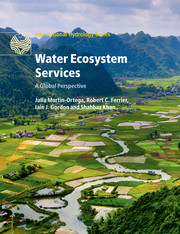Book contents
- Frontmatter
- Contents
- List of contributors
- Preface
- 1 Introduction
- 2 What defines ecosystem services-based approaches?
- Part I Addressing global challenges
- Part II Applying frameworks for water management and biodiversity conservation under an ecosystem services-based approach
- 6 Using ecosystem services-based approaches in Integrated Water Resources Management: perspectives from the developing world
- 7 Implementation of the European Water Framework Directive: what does taking an ecosystem services-based approach add?
- 8 How useful to biodiversity conservation are ecosystem services-based approaches?
- Part III Assessing water ecosystem services
- Part IV Broadening the perspective
- Index
- Plate Section
- References
8 - How useful to biodiversity conservation are ecosystem services-based approaches?
from Part II - Applying frameworks for water management and biodiversity conservation under an ecosystem services-based approach
Published online by Cambridge University Press: 05 May 2015
- Frontmatter
- Contents
- List of contributors
- Preface
- 1 Introduction
- 2 What defines ecosystem services-based approaches?
- Part I Addressing global challenges
- Part II Applying frameworks for water management and biodiversity conservation under an ecosystem services-based approach
- 6 Using ecosystem services-based approaches in Integrated Water Resources Management: perspectives from the developing world
- 7 Implementation of the European Water Framework Directive: what does taking an ecosystem services-based approach add?
- 8 How useful to biodiversity conservation are ecosystem services-based approaches?
- Part III Assessing water ecosystem services
- Part IV Broadening the perspective
- Index
- Plate Section
- References
Summary
8.1 INTRODUCTION
De Groot (1992), Daily (1997), and Costanza et al. (1997) were seminal publications in developing an approach based on ecosystem services that has come to dominate biodiversity conservation (see Chapter 2 for an overview of the term's evolution). The thinking these authors helped to pioneer has become a success by many measures. There are now more than 100 universities with programmes focused on ecosystem services research, and in 2013 in Europe alone, 28 universities offered Master's degrees in Ecosystem Services (www.mastersportal.eu). The Nature Conservancy, World Wildlife Fund, Conservation International, Wildlife Conservation Society, International Union for the Conservation of Nature, and Fauna and Flora International all have ecosystem services programmes and projects.
The conservation world has a history of embracing new approaches that later prove to have fewer benefits than anticipated. Initial exuberance for an approach is often followed by a reassessment of the approach. Integrated conservation and development projects (Sanjayan & Shen 1997 versus McShane & Wells 2004), biodiversity hotspots (Myers et al. 2000 versus Kareiva & Marvier 2003), and a landscape-level approach (Noss 1983 versus Sayer et al. 2013) are several examples. Of the 21 approaches in use by conservation organizations in 2002 (Redford et al. 2003), only half are still prominently mentioned as approaches on the websites of the same conservation organizations that used them a decade ago (Box 8.1). Conservation is a fundamentally optimistic endeavour that welcomes big, new ideas. Ecosystem services are perhaps the biggest of the current new ideas in conservation.
The attractiveness of ecosystem services-based approaches comes, inter alia, from their potential value to conservation; the approaches highlight the often-overlooked goods and services that nature provides and helps inform environmental decision-making (Fisher et al. 2009). Ecosystem services-based approaches make the ‘invisible’ benefits of nature more visible and make the link between the well-being of nature and the well-being of people explicit (core element 1 in Chapter 2).
- Type
- Chapter
- Information
- Water Ecosystem ServicesA Global Perspective, pp. 65 - 70Publisher: Cambridge University PressPrint publication year: 2015

